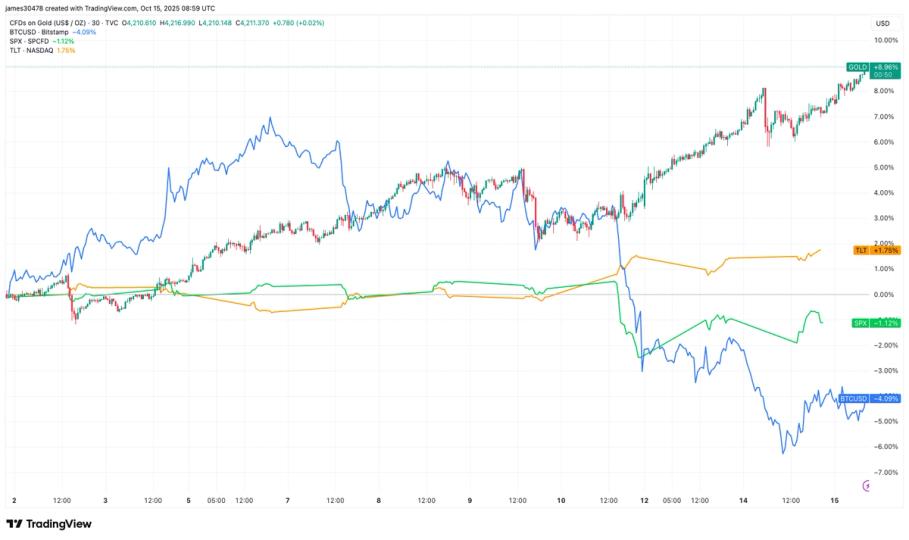Market Pulse
As the United States government once again faces potential fiscal standoffs, the crypto community is keenly observing the historical interplay between federal shutdowns and Bitcoin’s market performance. Past data reveals a fascinating pattern: some of Bitcoin’s most significant bear market bottoms have, perhaps coincidentally or causally, aligned with periods of government paralysis. This correlation prompts a deeper dive into whether a looming shutdown could act as a catalyst for a market reversal or merely add to existing volatility in the digital asset space.
Historical Precedent: Bitcoin’s Bear Market Bottoms and Shutdowns
Analyzing historical data, particularly from 2013 and 2018, offers intriguing insights. The October 2013 government shutdown, lasting 16 days, occurred when Bitcoin was still nascent but saw significant price action, eventually leading into its first major bull run. More strikingly, the record-breaking 35-day shutdown from December 2018 to January 2019 coincided almost precisely with Bitcoin’s bear market bottom at around $3,200, a level that marked the end of a protracted crypto winter. This confluence suggests that despite the uncertainty such political events generate, they haven’t always spelled doom for Bitcoin; in some instances, they preceded periods of strong recovery.
- 2013 Shutdown: Bitcoin was trading around $100-$150. Post-shutdown, it surged to over $1,000 by year-end.
- 2018-2019 Shutdown: Bitcoin hit its bear market low of ~$3,200 near the shutdown’s commencement, initiating a recovery phase shortly after.
- Underlying Factors: These events often occur amidst broader economic uncertainty, making it challenging to isolate the shutdown’s direct impact. However, Bitcoin’s non-sovereign nature potentially makes it an alternative during government instability.
The Mechanism of Impact: Why Shutdowns Matter
Government shutdowns disrupt various economic functions, potentially influencing traditional markets. A prolonged shutdown can lead to delayed economic data releases, reduced consumer confidence, and a general slowdown in federal spending, all of which can ripple through the broader economy. For Bitcoin, the implications are multi-faceted:
Firstly, the uncertainty generated by a shutdown can trigger a “flight to safety” among some investors. While gold has traditionally served this role, Bitcoin has increasingly been viewed as a digital alternative, particularly by younger investors or those disillusioned with traditional financial systems.
Secondly, a shutdown may lead to a temporary halt in regulatory advancements related to crypto, which could be seen as both a positive (less immediate pressure) and a negative (delayed clarity). The lack of economic data during such periods, as recently highlighted, can also lead to a lack of clear market direction, potentially favoring assets that operate outside conventional data-driven analyses.
Distinguishing Current Conditions
It is crucial to acknowledge that each economic and political climate is unique. While historical correlations are valuable, they are not guarantees. The crypto market of today is vastly different from that of 2013 or 2018. We have institutional adoption, regulated spot ETFs, and a much larger, more mature ecosystem. Global macroeconomic factors, such as inflation, interest rates, and geopolitical tensions, play a more significant role than ever before.
A contemporary shutdown could manifest different outcomes:
- Increased volatility as markets react to uncertainty.
- Potential for capital flight into perceived safe havens, including Bitcoin.
- A test of Bitcoin’s narrative as a truly uncorrelated asset amidst traditional financial stress.
Investor Sentiment and Macro Factors
Investor sentiment remains a critical driver. Should a shutdown trigger widespread panic in traditional markets, Bitcoin could initially experience sell-offs as investors deleverage across all asset classes. However, if the shutdown is perceived as a temporary political squabble rather than a deep economic crisis, Bitcoin’s narrative as a censorship-resistant, decentralized asset could gain traction, especially if confidence in government-backed fiat systems wanes.
The role of the U.S. dollar is also pivotal. If a shutdown weakens the dollar, assets priced in USD, like Bitcoin, could see an inverse reaction. Conversely, if global safe-haven flows strengthen the dollar despite domestic issues, Bitcoin might face headwinds. The market’s interpretation of these complex interactions will ultimately dictate Bitcoin’s trajectory.
Conclusion
The historical alignment of U.S. government shutdowns with Bitcoin’s bear market bottoms provides an intriguing, albeit not definitive, data point for investors. While past performance does not dictate future results, it highlights Bitcoin’s potential resilience in the face of governmental and traditional economic uncertainty. As the prospect of another shutdown looms, market participants will be watching closely to see if history offers any guideposts, or if the increasingly complex crypto landscape will forge a new narrative.
Pros (Bullish Points)
- Bitcoin has historically demonstrated resilience and even found bear market bottoms during periods of US government shutdowns.
- Potential for Bitcoin to act as a 'flight to safety' asset if confidence in traditional financial systems wanes due to government instability.
Cons (Bearish Points)
- Current macroeconomic conditions (inflation, interest rates, geopolitics) are different, meaning historical patterns may not repeat.
- Initial market reaction to a shutdown could still lead to broader risk aversion and selling pressure on all asset classes, including Bitcoin.
Frequently Asked Questions
What is a US government shutdown?
A US government shutdown occurs when Congress fails to pass appropriations bills or continuing resolutions, leading to a temporary halt in funding for non-essential federal government operations.
How has Bitcoin performed during past US government shutdowns?
Historically, some US government shutdowns, particularly in 2013 and 2018-2019, have coincided with or preceded significant bear market bottoms and subsequent recovery phases for Bitcoin.
Does a government shutdown guarantee a Bitcoin price surge?
No, historical correlations are not guarantees. While past shutdowns coincided with Bitcoin bottoms, the current market environment and macroeconomic factors are unique and could lead to different outcomes.



